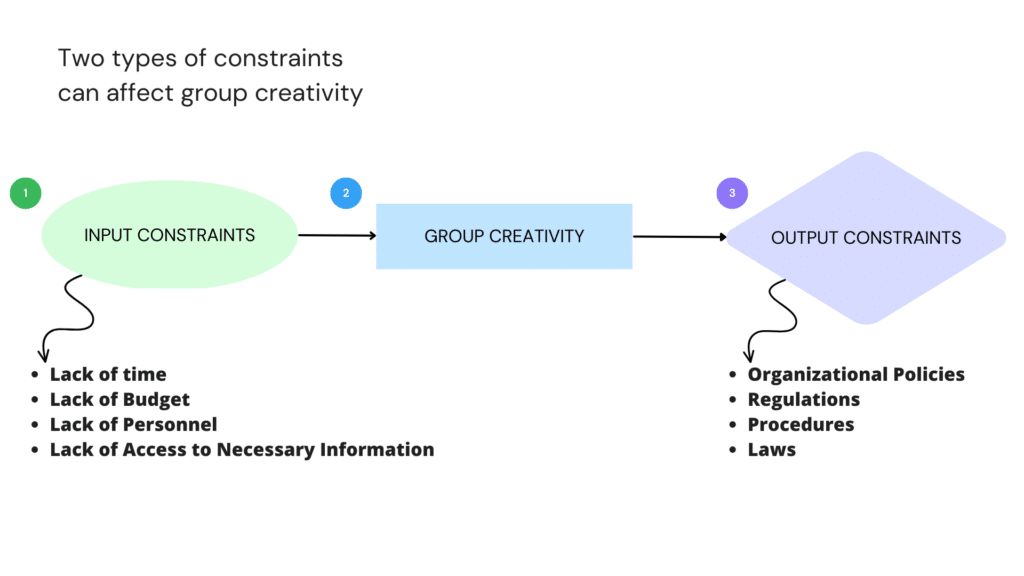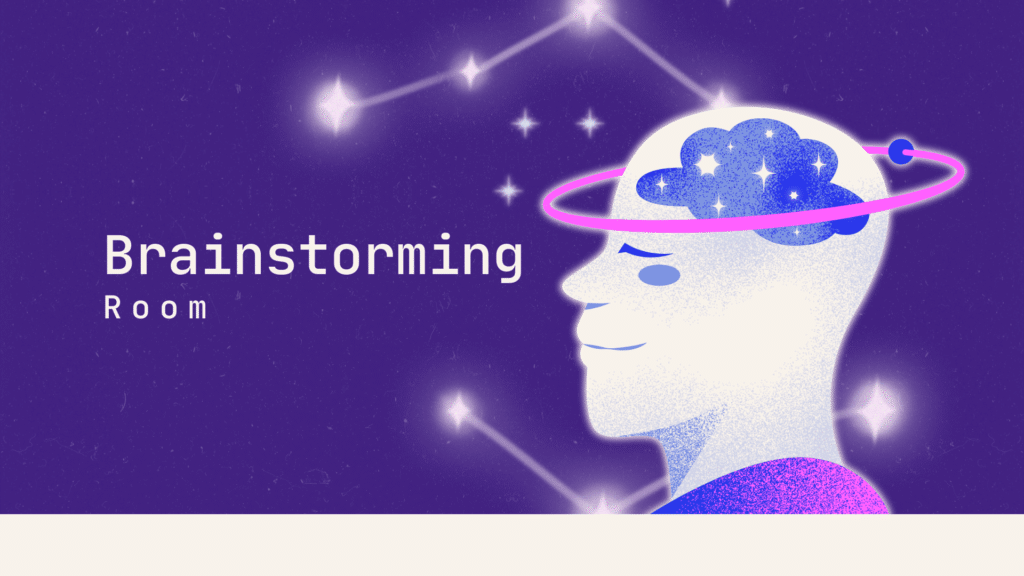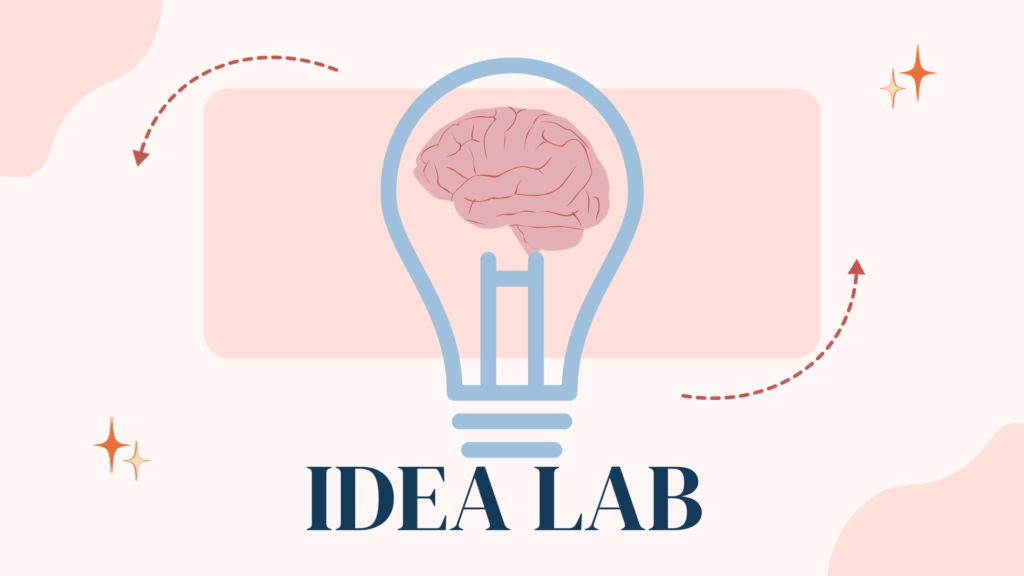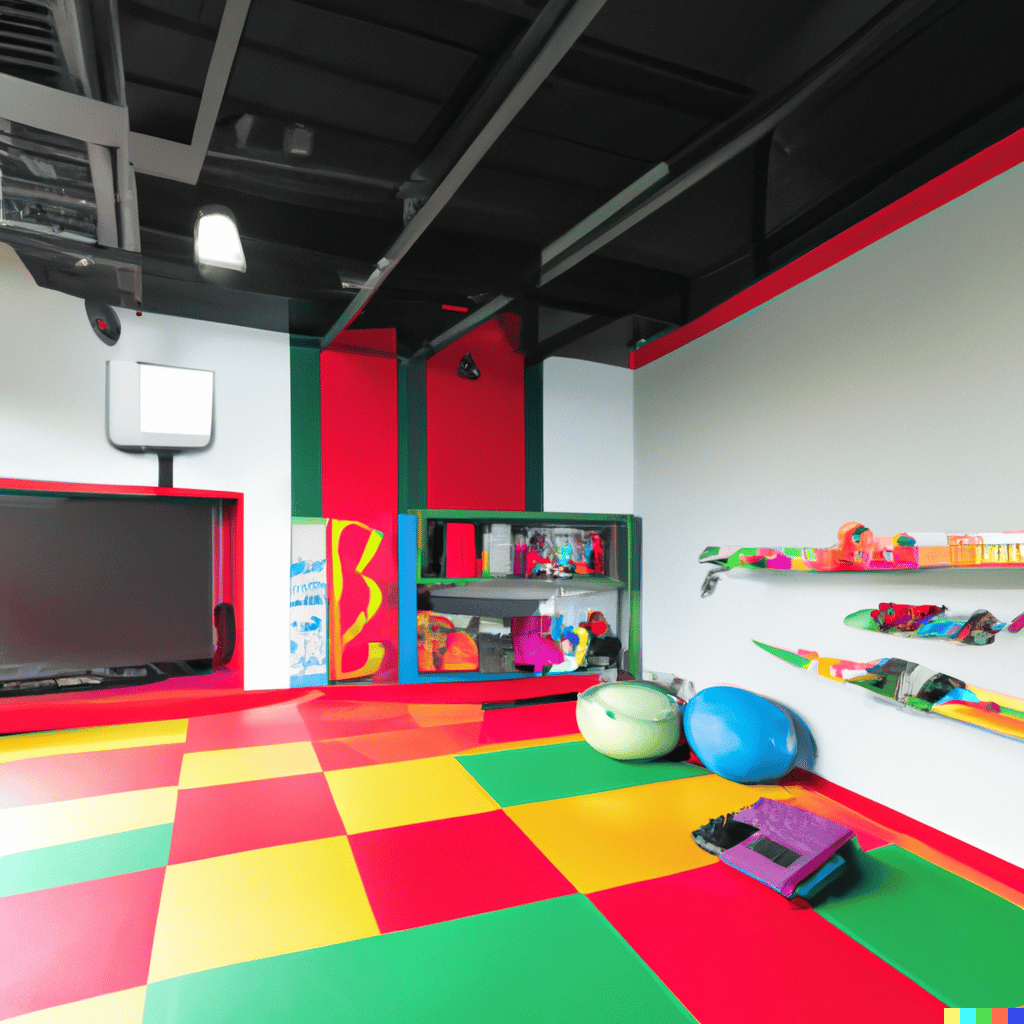Seeking Progress?

In our rapidly changing business world, a conducive work environment is crucial for a company’s success.
Environments like brainstorming spaces and idea labs foster out-of-the-box thinking, sparking breakthrough solutions.
Though similar in leveraging business knowledge for innovation, each of these environments boasts unique characteristics.
Creativity, the lifeline of progress and innovation, has ushered some of the most significant inventions and artistic masterpieces in history.
Yet, did you acknowledge that creativity isn’t confined to a one-man show?
Collective creativity, an anthem of shared ideas and mutual building, can pave the way for unparalleled breakthroughs and exceptional masterpieces.
In this blog, we’re set to explore the potency of collective creativity, its harnessing methods, and its importance in transcending limitations and propelling progress.
Hitch your wagon, folks, because we’re off on a voyage across the boundless landscape of group creativity!
Understanding Group Creativity

Welcome to the realm of group creativity, where the power of collaboration and diversity of perspectives results in the generation of fresh ideas and innovative solutions.
Group creativity refers to the collaborative process of generating new and innovative ideas or solutions as a team. It is a way of harnessing the collective knowledge, skills, and perspectives of a group to achieve a common goal.
It can be facilitated in various settings, including workshops, brainstorming sessions, and specially designed creativity rooms.
The goal is to encourage creative thinking and to generate new ideas that may not have been discovered through individual effort.
While group creativity offers many benefits, it’s important to consider how it differs from individual creativity.
Individual creativity involves generating ideas and solutions alone, group creativity is all about working together, pooling resources, and combining perspectives to reach a common goal.
The dynamic interplay of group creativity can result in breakthrough thinking, but it also requires strong collaboration skills, effective communication, and a willingness to embrace new ideas.
In the next section, we’ll see why group creativity can be such a powerful tool for organizations looking to drive innovation and growth.
What is the Importance of Group Creativity?
The collaborative process of generating new and innovative ideas as a team, known as group creativity, is a powerful tool for organizations looking to drive innovation and growth.
Group creativity is important for several reasons. Let’s go deeper into the most important reasons.
Diverse Perspectives
Group creativity leverages the diverse perspectives of group members to generate new ideas and solutions. This diversity of thought can lead to breakthrough thinking and result in more innovative solutions.
In a TEDX video, Ray Dalio spoke about how his business – Bridgewater Associates – uses the “idea meritocracy”, in which the best ideas would win out. He developed a system that you can put in place in your own business and scale that system to optimize decision-making.
In his system, group creativity is guided to bring truthfulness and transparency to everyone’s perspective. Meaning that he doesn’t want people to necessarily follow his ideas, and he also doesn’t want all ideas to be equal or democratized.
Everyone in his team sees or listens to what is said by each member of the group. This brings transparency to the members and it allows them to reflect on all the available information. To do so, Ray Dalio taped every conversation to be sure everybody sees everything.
Through time, Ray’s team went further by embedding those principles into algorithms. The result is that everyone can rapidly see the general decision-making from the team’s perspective. It is a way to manage the sum of all perspectives and it is way more powerful than individual creativity.
Improved Collaboration and Communication
Group creativity requires strong collaboration skills and effective communication. As a result, participating in group creativity can help improve these skills, which can have a positive impact on other areas of work and life.
When working in a group, individuals need to listen to and understand each other’s ideas, express their thoughts clearly, and work together towards a common goal. This fosters an environment of respect, empathy, and cooperation that helps to build stronger relationships and trust between team members.
As a business leader, you have the power to create an environment that encourages collaboration and communication, which is essential for unlocking the potential of group creativity. Without a culture that values open communication, active listening, and respect for diverse perspectives, team members may struggle to work together effectively. This can lead to misunderstandings, conflicts, and a lack of progress.
In addition, if you do not prioritize collaboration, silos may form within the organization, with individuals or departments working in isolation rather than sharing knowledge and resources. This can result in redundancy, inefficiency, and missed opportunities for innovation and growth.
Furthermore, a lack of collaboration and communication can negatively impact employee morale and job satisfaction. When individuals feel disconnected from their colleagues or don’t feel like their contributions are valued, they may become disengaged and less productive. This can ultimately lead to high turnover rates and negative company culture.
Therefore, as a business leader, you must prioritize collaboration and communication to foster an environment that supports group creativity. This can include creating cross-functional teams, providing opportunities for knowledge-sharing and professional development, and encouraging open and honest communication. By doing so, you can unlock the full potential of your teams and drive innovation, growth, and success.
What are the Constraints Affecting Group Creativity?
Constraints are factors that limit or restrict the ability of a group to generate new and innovative ideas.
Two types of constraints can affect group creativity: input constraints and output constraints.
- Input constraints refer to the limitations on the resources and information available to the group. This can include a lack of time, budget, personnel, or access to necessary information. Input constraints can make it difficult for a group to fully explore and develop their ideas, as they may not have the resources they need to bring their ideas to life.
- Output constraints refer to limitations on the outcomes that can be produced by the group. This can include limitations imposed by organizational policies, regulations, or procedures. Output constraints can limit the ability of the group to implement their ideas and solutions, as they may be limited by external factors beyond their control.
To overcome these constraints, organizations need to identify the constraints affecting their group creativity and take steps to mitigate them. This may involve finding ways to increase the resources and information available to the group, as well as exploring alternative solutions that are not impacted by output constraints. By understanding and addressing these constraints, organizations can increase the effectiveness of their group creativity and achieve better outcomes.
According to Acar & Al, input constraints are widely studied across strategic management, entrepreneurship, organizational behavior, and marketing. The focus of study in these fields includes the lack or excess of financial, material, human, and time resources and their impact on motivation and creativity.
Research shows that while slack resources can increase R&D spending and patent applications, time pressure can reduce intrinsic motivation and creativity. However, limited resources can also stimulate entrepreneurial growth and innovation.
Overall, the impact of input constraints on creativity and innovation is a complex issue and further research is needed to understand the underlying mechanisms.
On the flip side, let’s look at output constraints. According to Acar & Al, recent studies have shown that regulations and standards can spur organizations to innovate to comply with requirements. Product design specifications can also stimulate creativity and innovation.
While there is limited evidence on how output constraints affect creativity and innovation, it is suggested that these constraints can positively influence creative outcomes by providing a stable interface to build on, codifying accumulated knowledge on which innovations can be built, and delineating search boundaries. Although some researchers argue that output constraints can have motivational effects, empirical evidence is lacking to support these claims.
Overall, prior research on output constraints has mainly focused on regulations, standards, and product design specifications, with researchers offering theoretical reasoning and empirical evidence for a positive relationship between output constraints and creativity and innovation.
While output constraint optimization is more limited, one of the best ways to optimize input constraints is by putting in place rooms that help employees unlock their creative potential and foster innovation.
And what better way to do this than with a dedicated brainstorming room or an idea lab?
Both brainstorming rooms and idea labs can be incredibly valuable for companies looking to innovate and stay ahead of the competition. By providing a space for employees to think creatively and experiment with new ideas, these rooms can lead to breakthroughs that would not be possible otherwise.
Brainstorming Room
A brainstorming room is a haven for creativity, collaboration, and innovation. But what exactly is a brainstorming room and why is it important?
What is a Brainstorming Room?
You are probably looking for a way to boost productivity and enthusiast for your business to come up with better ideas. A brainstorming room will accelerate employees’ path to creative thinking.
A brainstorming room is a dedicated space for individuals or teams to come together and generate and exchange ideas. It’s a place where free-thinking, out-of-the-box solutions and open communication are encouraged. The goal of a brainstorming room is to foster creativity, promote collaboration, and drive innovation.
Building a brainstorming room can seem like a daunting task. That is why we built a 9-step guide showing how to build a brainstorming room, you’ll have everything you need to get started.
Our guide covers everything from defining your goals and finding the right space to setting up the right equipment and creating a welcoming atmosphere. We also provide tips on how to make your brainstorming room as productive and effective as possible.
Whether you’re looking to build a brainstorming room for your business, organization, or community, our guide is a must-read.
What is the Main Purpose of Brainstorming?
Brainstorming is a group problem-solving technique that encourages free-thinking, out-of-the-box solutions, and open communication.
The main purpose of brainstorming is to generate a large number of creative ideas and solutions in a short period. The goal is to stimulate creative thinking and produce as many ideas as possible, without immediate judgment or criticism, to find the best solution to a problem or challenge.
As we show in our guide on how to build a brainstorming room, to stimulate employees you need to set the room in particular ways.
For example, you can manage the lighting of the room in an ambient and warm light that will help thinkers relax and come up with ideas they couldn’t think of in a stressful environment.
Brainstorming is often used in a variety of settings, including businesses, schools, and community organizations, to drive innovation and solve problems.
Why is a Brainstorming Room Important?
A brainstorming room is crucial in fostering creativity and promoting collaboration. It’s a space where individuals and teams can come together to exchange ideas and take risks, leading to breakthrough innovations.
A brainstorming room provides a dedicated and distraction-free environment for individuals and teams to collaborate and exchange ideas. In this type of setting, participants are encouraged to think freely, share their thoughts, and build upon each other’s suggestions. This type of open and supportive atmosphere can lead to the generation of a large number of new and innovative ideas.
Additionally, a brainstorming room can serve as a neutral and inclusive space where everyone feels comfortable participating and sharing their ideas. This can help to reduce tension and competition and promote teamwork and cooperation. It also allows team members to think outside the box and take risks without fear of judgment or criticism, which can lead to breakthrough innovations.
Furthermore, a brainstorming room is often equipped with the tools and resources necessary for effective collaboration, such as whiteboards, projectors, and comfortable seating. This can help to increase productivity and encourage participants to focus on the task at hand.
What is the Difference Between a Brainstorming Room and an Idea Lab?
While a brainstorming room and an idea lab both serve as spaces for idea generation and collaboration, there are some key differences between the two.
A brainstorming room is typically a more structured environment designed specifically for group problem-solving sessions. The goal of a brainstorming room is to generate as many ideas as possible in a short period, without immediate judgment or criticism. This type of setting is often used for specific projects or problem-solving sessions and may be used regularly.
On the other hand, an idea lab is a more flexible and open-ended space that is dedicated to fostering creativity and innovation. An idea lab may be used by individuals or teams for extended periods and may include tools and resources for prototyping and testing new ideas. This type of environment is often less structured than a brainstorming room and is designed to encourage long-term, ongoing exploration, and experimentation.
In short, while both a brainstorming room and an idea lab serve as spaces for idea generation, a brainstorming room is designed for structured, short-term problem-solving sessions, while an idea lab is more flexible and designed for ongoing exploration and experimentation.
Idea Lab
An idea lab is a space dedicated to exploring and experimenting with new and cutting-edge ideas. But what exactly is an idea lab and why is it important?
What is an Idea Lab?
In an idea lab, there is no limit to what you can do. Whether you’re exploring a new concept, testing a prototype, or developing a new product, the goal is to support your creative process and help you bring your ideas to life. The relaxed, supportive environment of an idea lab encourages risk-taking, free-thinking, and open communication, leading to the generation of new and innovative solutions.
An idea lab is a creative and innovative environment designed to support the ideation and prototyping process. It provides a space for individuals and teams to come together to brainstorm, test new ideas, and develop prototypes of their concepts. The goal of an idea lab is to provide a supportive environment that fosters creativity, experimentation, and innovation.
In short, an idea lab is a dedicated space for ideation and prototyping. It provides a supportive environment for individuals and teams to come together to brainstorm, test new ideas, and bring their concepts to life. With the right tools and resources, an idea lab can help drive innovation and push boundaries, leading to breakthrough innovations and cutting-edge products.
Why is an Idea Lab Important?
In an idea lab, individuals and teams have the freedom to think big and dream up new solutions to complex problems. They have access to the latest tools and resources needed to bring their ideas to life, such as virtual and augmented reality systems, 3D printers, and more. With this support, they can explore new ideas, test prototypes, and develop cutting-edge products and technologies.
An idea lab is important because it provides a dedicated space for exploring new ideas and experimenting with cutting-edge technologies.
In today’s fast-paced and ever-changing world, innovation is key to success. An idea lab provides a supportive and collaborative environment for individuals and teams to come together.
They can create new and innovative solutions that help your business to grow by taking care of complex problems and driving progress in their field.
An idea lab also encourages collaboration and cross-disciplinary thinking. By bringing together individuals and teams from different backgrounds and areas of expertise, an idea lab fosters a culture of collaboration and teamwork. This leads to new and innovative solutions that would not have been possible if individuals were working alone. In other words, it is called technological collaboration.
An idea lab is important because it provides a supportive and collaborative environment for exploring new ideas, experimenting with cutting-edge technologies, and promoting innovation.
What is the Main Purpose of an Idea Lab?
An idea lab is not just a place, it’s a mindset. It’s a way of thinking that values creativity, exploration, and experimentation. It’s where individuals and teams can take the time to think big and dream up new solutions to complex problems. And, with the right tools and resources, an idea lab can help turn these big ideas into tangible, real-world solutions.
The main purpose of an idea lab is to foster creativity, experimentation, and innovation. It’s a space where individuals and teams can come together to explore new ideas, test prototypes, and challenge the status quo.
By providing a supportive and collaborative environment, an idea lab encourages risk-taking, free-thinking, and open communication. This leads to the generation of new and innovative solutions and the development of cutting-edge products and technologies.
An idea lab is used to drive innovation and challenge assumptions to think outside the box. It’s a space where individuals and teams can come together to unleash their creativity and take their ideas to the next level!
Additional Factors of Group Creativity
Whether it’s a bustling brainstorming room, a cutting-edge idea lab, or a high-tech R&D facility, these spaces must ignite the passions and ignite minds of those who work within them.
From comfort and ergonomics to technology and aesthetics, every aspect of these spaces must be carefully crafted to inspire and motivate.
And just as importantly, they must foster collaboration and communication, promoting teamwork and idea-sharing at every turn. With the right environment, employees can soar to new heights of creativity and productivity, driving a company to greatness.
These spaces are not just a luxury, but a necessity – they are the engines of progress, fueling our collective passion to create and innovate.
How can Music Influence your Team Member’s Brains?
Music has a significant impact on our brains and affects various aspects of our mental and emotional states. The rhythm, melody, and lyrics of a piece of music can stimulate the release of neurotransmitters and hormones in our brains, resulting in physiological and psychological changes.
Music can also help in reducing stress and anxiety, improving mood and memory, and promoting relaxation and sleep.
Additionally, listening to music can activate different regions of the brain and influence our emotions, thoughts, and behavior. In conclusion, music has a powerful influence on the brain, and its effects on our mental and emotional states are both complex and far-reaching.
Why Should Your Team Listen to Music Without Lyrics?
Listening to music without lyrics can help you concentrate because it provides consistent, non-distracting background noise. This can help block out external distractions and create a calm, focused environment for your brain to work in.
Furthermore, certain types of instrumental music have been shown to have a positive effect on brain activity, increasing motivation and focus. This makes it an ideal choice for people who need to concentrate on tasks that require deep concentration, such as reading, writing, or problem-solving.
Listening to music without lyrics can be a useful tool for improving focus and concentration in various activities.
Here are some examples of different kinds of music our team members use for certain purposes :
How can Lighting Improve your Team’s Performance?
Lighting is a crucial factor in the performance and well-being of employees in the workplace. Adequate lighting can improve visual comfort, reduce stress levels, and increase motivation and productivity, while poor lighting can have the opposite effect.
By regularly assessing the lighting in the workplace and making necessary adjustments, you can create a positive and supportive work environment for your team.
To learn more about how lighting can improve team performance and the benefits of good lighting design in the workplace, be sure to check out our full article on 7 Easy Steps to Understand Lighting for Your Office.
How can Comfort Influence your Team’s Productivity?
Comfort is a crucial factor in determining the productivity of a team. Comfortable employees tend to be more relaxed, focused, and motivated, leading to increased productivity. To create a comfortable work environment, it’s important to provide ergonomic furniture and equipment such as the Duramont Ergonomic Adjustable Office Chair that provides excellent lumbar support and an adjustable desk such as the FEZIBO Electric Height Adjustable Standing Desk that helps reduce physical strain and discomfort and increase focus and concentration.
It’s also important to maintain appropriate lighting, temperature control, and air quality to create a healthy work environment, and the HEPA Air Purifier for Home, Allergens, and Odors Eliminator can help with that. By creating common areas such as a lounge or a brainstorming room, employees can take a break, relax, and socialize, leading to a positive and welcoming atmosphere that can enhance comfort and productivity.
A brainstorming room and an idea lab are spaces specifically designed for creative thinking and problem-solving. These rooms typically include whiteboards, comfortable seating, and other tools and materials that facilitate brainstorming sessions. The AmazonBasics Magnetic Dry Erase Board is a great tool that can help in a brainstorming session.
The rooms can create a comfortable and relaxed environment where employees can collaborate and share ideas, leading to increased productivity and better problem-solving.
Conclusion
In conclusion, group creativity is a powerful tool that can lead to innovative solutions and breakthrough ideas. By leveraging the diversity of perspectives and experiences of a team, organizations can overcome challenges and drive growth.
The rooms discussed in this blog post – the brainstorming room and the idea lab – are essential components of a successful business.
These rooms provide a dedicated space for creative thinking, product development, and problem-solving. By investing in these rooms, a business can foster a culture of innovation and collaboration, ultimately leading to improved outcomes and growth.
So, it’s time to start thinking outside the box and create a space that allows your business to reach its full potential!
Bibliographic Sources :
- This blog post was written with the assistance of an AI language model, specifically ChatGPT. While the model generated the initial content, it has been extensively revised, edited, and fact-checked by the author to ensure accuracy and compliance with Google’s guidelines. The author takes full responsibility for the final product and any errors or inaccuracies that may remain.













